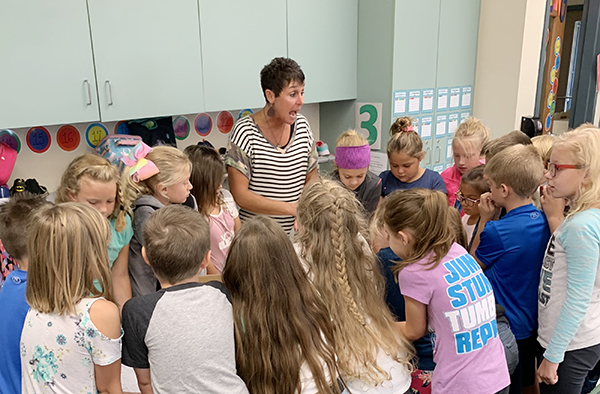AG in the Classroom is More than Cattle and Grain

Photo furnished
Ag in the Classroom
With Ag in the Classroom back for a new season, September’s lesson was on apples. Stephanie Naylor visited Sullivan and Okaw Valley Elementary schools. The Kindergarten and First graders tasted three popular types of apples and filled out a worksheet picking their favorite and completing a craft. The second, third and fourth graders learned several apple facts and completed an experiment creating an apple volcano. Naylor will meet with students one time a month to discuss a variety of Agriculture related topics.
•October 16, 2019•
By Ellen Ferrera
for the News Progress
Stephanie Naylor has, for several years, been the Moultrie County instructor for the Ag in the Classroom program.
In that capacity she visits every K-3 class in Moultrie County once a month for 20 minutes and, in a year, teaches over 6,000 students about the wonders of agriculture through a variety of interactive programs. But such agricultural experiences were not always available.
Throughout much of our history, agriculture and education have been closely related. Old school books are full of agricultural reference because farming was part of nearly every child’s life prior to 1920.
From 1920-1950 farm populations shrank, agricultural emphasis decreased in books and agricultural education became more of an occupational specialty or a trade school course. Ag classes had virtually disappeared from most curriculums.
In 1981 the U. S. Department of Agriculture invited educators and representatives of agricultural organizations to discuss agricultural literacy and to form a task force to help bring agriculture back into the classroom. That same year the national program – Ag in the Classroom – was established and, as result, each state now addresses agricultural education in ways best suited to its own needs.
Login or Subscribe to read the rest of this story.
Sue Yarnell, now retired, remembers when she took over the program in 2009, “I was so grateful to the Soil and Water District for giving me office space and being so supportive of our program. They paid half my salary and we couldn’t have done it without them.” Sue is now the President of the Moultrie County Retired Teachers Association.
Sue ran the program for six and a half years and her first lesson was taking classes to a pumpkin farm.
“Many of the children had never seen Cinderella or Lady Godiva pumpkins or ones with bumpy skins. From the Amish store I got raw pumpkin seeds for the children to chew on and this was a new experience for many of them.”
She developed an insect kit and did programs on soybeans, beeswax and helped the classes make hand lotion from soy bean oil.
“The point,” she said, “was to teach the children that agricultural was more than cattle and grain.”
Naylor continues the story.
“Every county receives grants from the Soil and Water District and these grants are administered by the Farm Bureau,” the Ag in the Classroom instructor continued.
“Through the national program we can get kits and a variety of lesson plans on topics as diverse as Aquaponics, wool production, root systems, walnut farms and photosynthesis but we really enjoy creating our own to relate to the agriculture in our areas.”
Naylor’s classes explore the various types of apples and making volcanos with apples, baking soda and vinegar.
They also make pumpkin pie in a bag, study bees and pollinators, and visit a farm to see all the livestock.
“I just love seeing their faces light up,” she said of the rewards of seeing a child learn. “Ag in the Classroom, with its hands-on experiences is greatly enjoyed by the children as a diversion from regular classroom classes.”
Naylor stresses the importance of involving the community as part of the grant requirement.
Ag in the Classroom is also supported by ADM, Illinois Pork Producers, Illinois Beef Producers, Illinois Soybean Growers and Illinois Corn Growers.
“They contribute so much – even a bookmark or a calendar from one of these groups is appreciated by the children,” she added.
Stephanie Naylor comes from family of farmers who farm over 1,000 acres, mostly in Shelby County.
She appreciates that Ag in the Classroom will ensure that future generations of children will continue to learn the importance of agriculture to our health, economy and environment.
